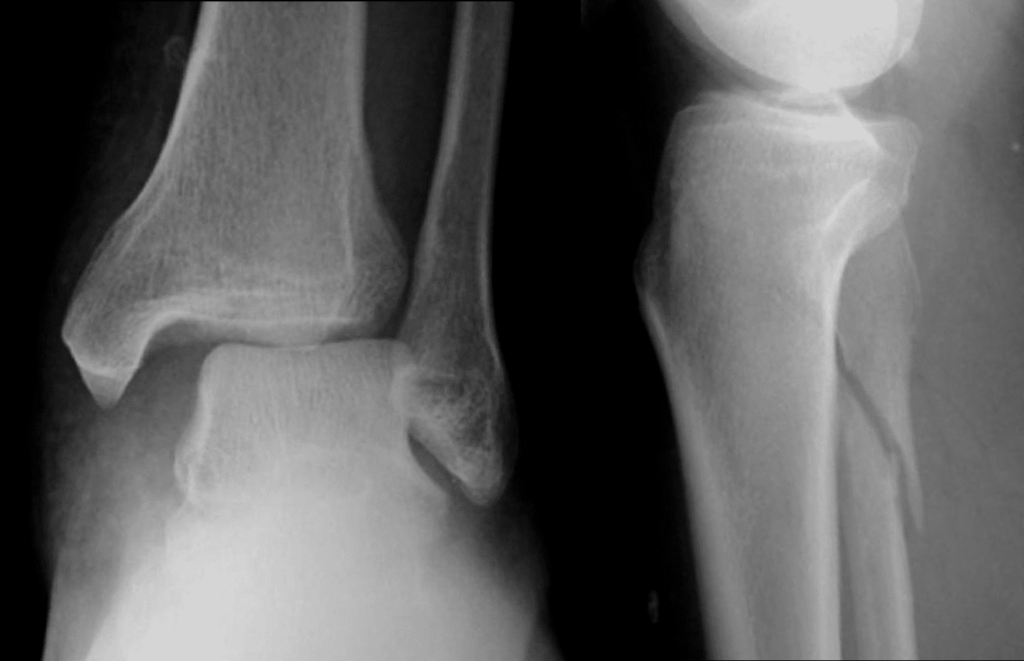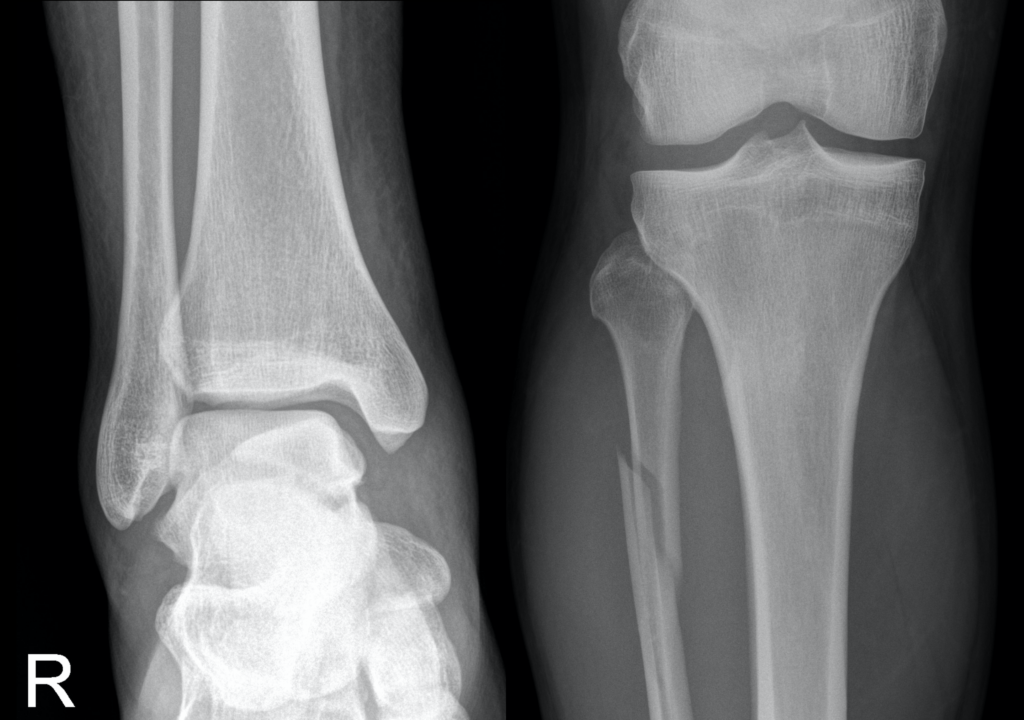Maisonneuve Fracture
Description: The Maisonneuve Fracture
The Maisonneuve fracture is a spiral fracture of the upper third of the fibula associated with a tear of the distal tibiofibular syndesmosis and the interosseous membrane. There is an associated fracture of the medial malleolus or rupture of the deep deltoid ligament
Rupture of the stabilizing ligaments of the distal tibiofibular syndesmosis will result in widening of the ankle mortise on radiographs. Additional findings such as avulsion fracture of the medial or posterior malleoli, or tear of the deltoid ligaments may also be present

History of the Maisonneuve Fracture
1840 – Maisonneuve described, using cadaveric studies, how an external rotation force applied to the foot could result in a fracture of the proximal third of the fibula
1er Groupe- Déviation de la pointe du pied en dehors
J’ai placé la jambe horizontalement sur le bord d’une table, ou dans les mors d’un étau, puis saisissant à pleine main la pointe du pied, je l’ai portée violemment dans l’abduction…
…lorsque les ligaments tibio-péroniers se brisent, ce qui doit arriver quand la résistance des malléoles est supérieure à la leur, le premier effet de la déviation du pied en dehors est une diastase, un écartement plus ou moins considérable des deux os. Si le mouvement se continue, le péroné ne tarde pas à se rompre; mais la fracture alors affecte un siège remarquable. Ce n’est plus au tiers inférieur, mais au tiers supérieur… qu’on la rencontre
First Group – Deviation of the end of the foot outwards
I placed the leg horizontally on the edge of a table, or in the grip of a vice, then holding the end of the foot with my whole hand, I drew it violently into abduction…
…if the tibio-peroneal ligaments rupture, which must happen when the resistance of the malleoli is superior to that of the former, the first effect of deviating the foot outwards is a diastasis, a relatively considerable widening of the two bones. If the movement continues, it is not long before the fibula breaks; but the fracture affects a notable site. It is no longer in the lower third, but rather in the upper third… that we find it.
Associated Persons
- Jacques Gilles Maisonneuve (1809-1897)
Controversies
In the case of an isolated medial malleolar fracture or medial ankle ligament rupture, a proximal fibula fracture (indicative of a rupture of the syndesmosis and interosseous membrane) should be excluded [J Emerg Med. 2013;44(2):e251-5]
Fracture of the proximal fibula as a result of a pronation external rotation or supination external rotation mechanism of the foot and ankle should be differentiated from an isolated fibula fracture caused by direct force transmission from the lateral aspect.
Maisonneuve fractures should be suspected whenever there is lateral talar displacement or tibiofibular widening without distal fibula fracture. Stress radiographs and full-length tibiofibular radiographs should be obtained
References
- Maisonneuve JG. Recherches sur la fracture du péroné. Archives générales de médecine 1840; 7: 165-187 and 433-473
- Pankovich AM. Maisonneuve fracture of the fibula. J Bone Joint Surg Am. 1976; 58(3): 337-42.
- Israeli A, Horoszowski H, Chechick A, Farine I. Beware the “simple” fibular fracture (a clue for severe unstable ankle injury). Br J Sports Med. 1981; 15(4): 269–271.
- Hanson JA, Fotoohi M, Wilson AJ. Maisonneuve fracture of the fibula: implications for imaging ankle injury. American Journal of Roentgenology. 1999; 173: 702-702.
- Kalyani BS, Roberts CS, Giannoudis PV. The Maisonneuve injury: a comprehensive review. Orthopedics. 2010; 33(3): 190-5.
- Millen JC, Lindberg D. Maisonneuve fracture. J Emerg Med. 2011; 41(1): 77-8.
- Stufkens SA, van den Bekerom MP, Doornberg JN, van Dijk CN, Kloen P. Evidence-based treatment of Maisonneuve fractures. J Foot Ankle Surg. 2011; 50(1): 62-7
- Taweel NR, Raikin SM, Karanjia HN, Ahmad J. The proximal fibula should be examined in all patients with ankle injury: a case series of missed maisonneuve fractures. J Emerg Med. 2013; 44(2): e251-5.
- Somford MP, Wiegerinck JI, Hoornenborg D, van den Bekerom MPJ. Ankle fracture eponyms. JBJS 2013; 95(24): e198
- Deng F, Weerakkody Y. Maisonneuve fracture. Radiopaedia
- Eponymythology: Eponymous ankle and talus injuries. LITFL
[cite]
eponymictionary
the names behind the name
Resident medical officer in emergency medicine MB ChB (Uni. Dundee) MRCS Ed. Avid traveller, yoga teacher, polylinguist with a passion for discovering cultures.



